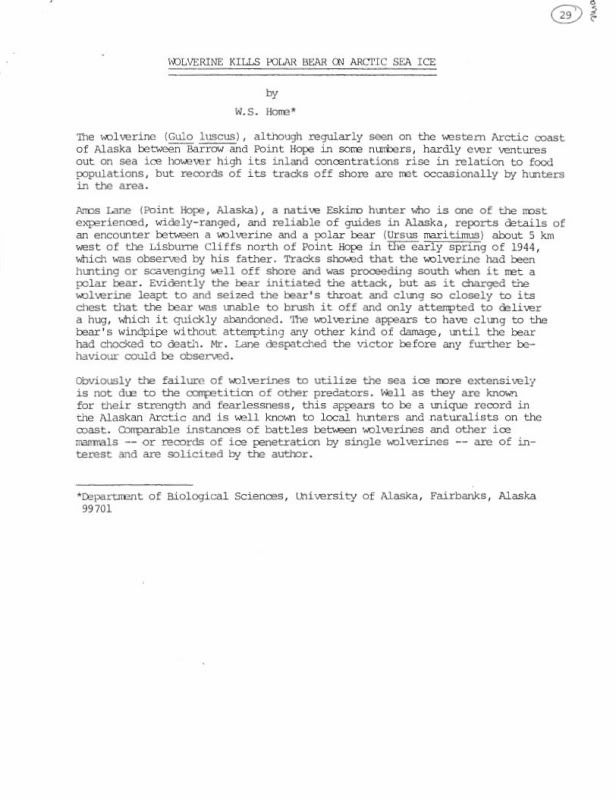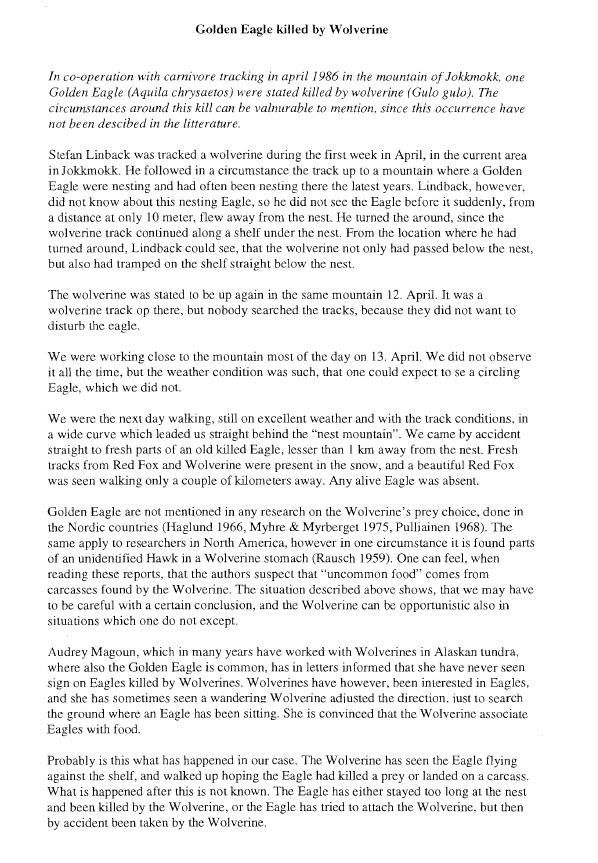Post by Vodmeister on Mar 8, 2014 11:04:50 GMT 5
Gulo gulo

The wolverine (Gulo gulo) is the largest terrestrial species of the Mustelidae or weasel family, and is also called the glutton or carcajou. It is the only species currently classified in the genus Gulo. Three subspecies are recognised, the Old World form Gulo gulo gulo and the New World forms G. g. luscus and G. g. vancouverensis.
The wolverine has been recognized as endangered since 2003. It has been hunted because of the fine quality of its pelt.
The wolverine is a stocky and muscular omnivorous, but primarily carnivorous, animal. It has glossy brownish-black hair with stripes of light brown along the sides. The fur is long and dense and does not retain much water. This makes it very resistant to frost in the cold environment where wolverines live. The wolverine can weigh up to 25 kg (55 lb) (male), and is 70–110 cm (27–43 in) long with a 20 cm (8 in) tail. It resembles a small bear with a long tail. It has also been known to give off a strong, unpleasant odor, giving rise to the use of the term "skunk bear" to describe the animal.
The wolverine is extremely strong for its size and has been known to kill animals as large as moose.[1] Its preference for reindeer has caused it to be hunted significantly in areas depending economically on caribou herds, and its status is sometimes in danger in such regions. It is generally not aggressive toward humans, preferring to avoid human contact. However, because a wolverine will attack an animal caught in a trap, early trappers often tried to kill them. They have been filmed capturing kills from other predators, such as polar bears or a wolf pack. Wolverines are the most ferocious of the Mustelidae family, and could easily dispatch all other Mustelids. Wolverines mate in the summertime, but implantation in the uterus is delayed until early winter, which delays the development of the fetus. Females will often not produce young if food is scarce. The young, usually three or four, are born in the spring. The young kits develop rapidly, becoming adult size within the first year of up to thirteen years of life.
It is currently found primarily in arctic regions such as Alaska, northern Canada, Siberia and Scandinavia. Wolverines have also been spotted in Russia and Baltic countries. Before the widespread European settlement of North America, however, it was found as far south as the Sierra Nevadas in California. A small number remain in the Rocky Mountain states. The present worldwide wolverine population is unknown, although it appears that the animal has a very low population density throughout its range, possibly as a result of illegal hunting. Wolverines, especially males, require large home ranges. The wolverine is still trapped for its fur in some parts of its range.
en.wikipedia.org/wiki/Wolverine
The wolverine (Gulo gulo) is the largest terrestrial species of the Mustelidae or weasel family, and is also called the glutton or carcajou. It is the only species currently classified in the genus Gulo. Three subspecies are recognised, the Old World form Gulo gulo gulo and the New World forms G. g. luscus and G. g. vancouverensis.
The wolverine has been recognized as endangered since 2003. It has been hunted because of the fine quality of its pelt.
The wolverine is a stocky and muscular omnivorous, but primarily carnivorous, animal. It has glossy brownish-black hair with stripes of light brown along the sides. The fur is long and dense and does not retain much water. This makes it very resistant to frost in the cold environment where wolverines live. The wolverine can weigh up to 25 kg (55 lb) (male), and is 70–110 cm (27–43 in) long with a 20 cm (8 in) tail. It resembles a small bear with a long tail. It has also been known to give off a strong, unpleasant odor, giving rise to the use of the term "skunk bear" to describe the animal.
The wolverine is extremely strong for its size and has been known to kill animals as large as moose.[1] Its preference for reindeer has caused it to be hunted significantly in areas depending economically on caribou herds, and its status is sometimes in danger in such regions. It is generally not aggressive toward humans, preferring to avoid human contact. However, because a wolverine will attack an animal caught in a trap, early trappers often tried to kill them. They have been filmed capturing kills from other predators, such as polar bears or a wolf pack. Wolverines are the most ferocious of the Mustelidae family, and could easily dispatch all other Mustelids. Wolverines mate in the summertime, but implantation in the uterus is delayed until early winter, which delays the development of the fetus. Females will often not produce young if food is scarce. The young, usually three or four, are born in the spring. The young kits develop rapidly, becoming adult size within the first year of up to thirteen years of life.
It is currently found primarily in arctic regions such as Alaska, northern Canada, Siberia and Scandinavia. Wolverines have also been spotted in Russia and Baltic countries. Before the widespread European settlement of North America, however, it was found as far south as the Sierra Nevadas in California. A small number remain in the Rocky Mountain states. The present worldwide wolverine population is unknown, although it appears that the animal has a very low population density throughout its range, possibly as a result of illegal hunting. Wolverines, especially males, require large home ranges. The wolverine is still trapped for its fur in some parts of its range.
en.wikipedia.org/wiki/Wolverine







